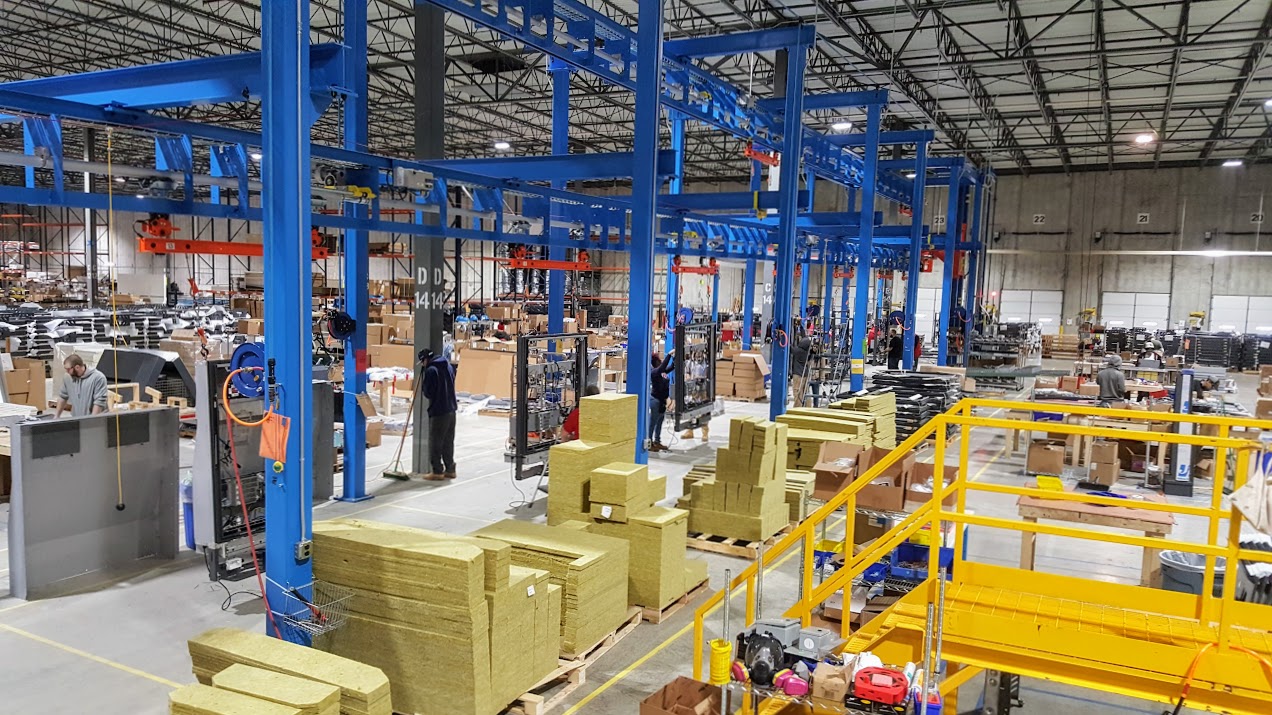
Stratacache Adopts Auto Plant Practices To Produce New Drive-Thru Displays By 1,000s At Dayton Factory
January 24, 2018 by Dave Haynes
Dayton, Ohio-based STRATACACHE is known primarily in the digital signage industry as an aggressive, fast-moving software and solutions company, and I doubt many industry people think about the company as a hardware manufacturer.
But STRATACACHE is now very seriously into manufacturing outdoor-ready displays for the largest U.S. and Canadian QSR chains, using the kind of equipment and process more normally used to make cars and trucks.
CEO Chris Riegel and his VP Display Solutions Bruno Pupo invited me down to Dayton yesterday (this gig is endlessly glamorous) to see the company’s new manufacturing facility on Stratacache Way in a suburban part of the city, to get a rundown on both the back-story, and see what’s now going on.
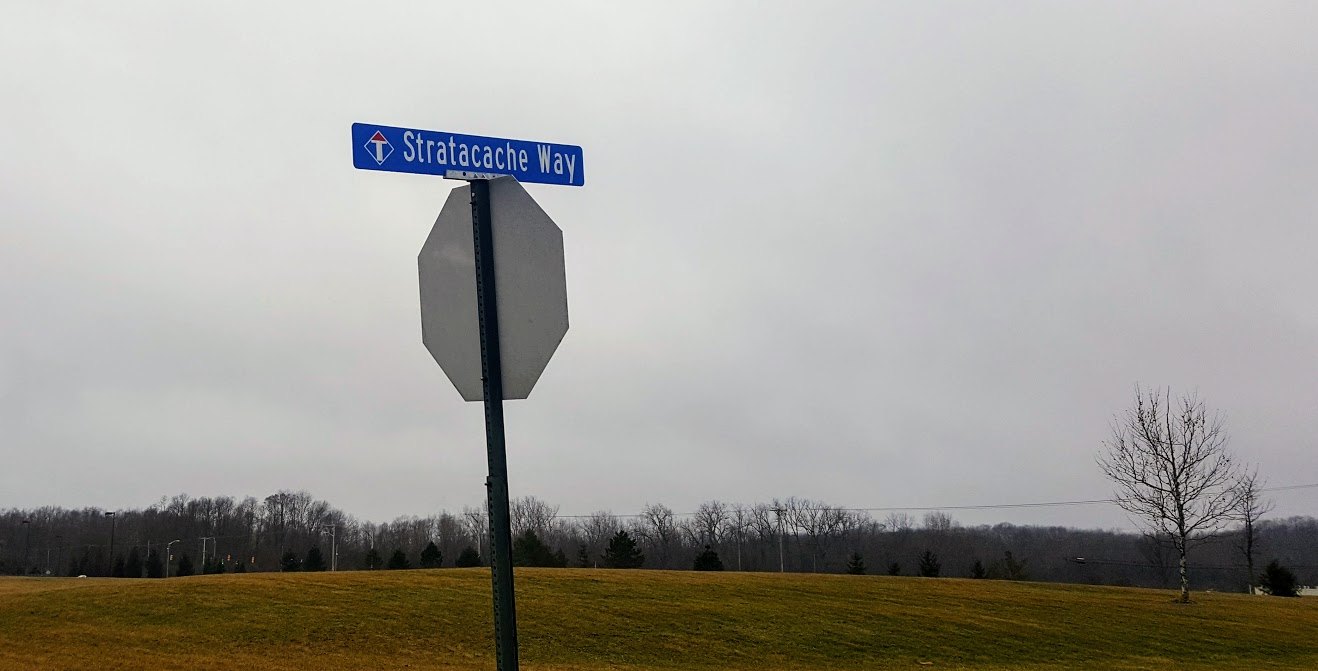
Riegel bought a vacant 380,000 auto parts distribution center in mid-2016 and now has a production line capable of spitting out a new outdoor display – for use in drive-thru lanes as pre-sell and menu displays – as quickly, eventually, as every four minutes. STRATACACHE had one shift going when I was there Tuesday, but Riegel expects to have three going as the year progresses. He estimated 40,000-50,000 displays could be made and shipped this year out of the factory.
The place is so big the far end has a rail line spur that comes through a roll-up door inside the building, enabling finished product to load directly into rail cars.
Riegel hired an ex-Toyota manufacturing plant manager to develop both the processes and disciplines needed to realize big production yields and minimal chaos. “So that is Will Brown and his team, doing QA, QC, lean manufacturing … all the stuff that they are really good at, that I had literally no idea how to do,” says Riegel.
Pupo oversees the whole thing, cycling (often) from Toronto, where an R&D office is being set up.
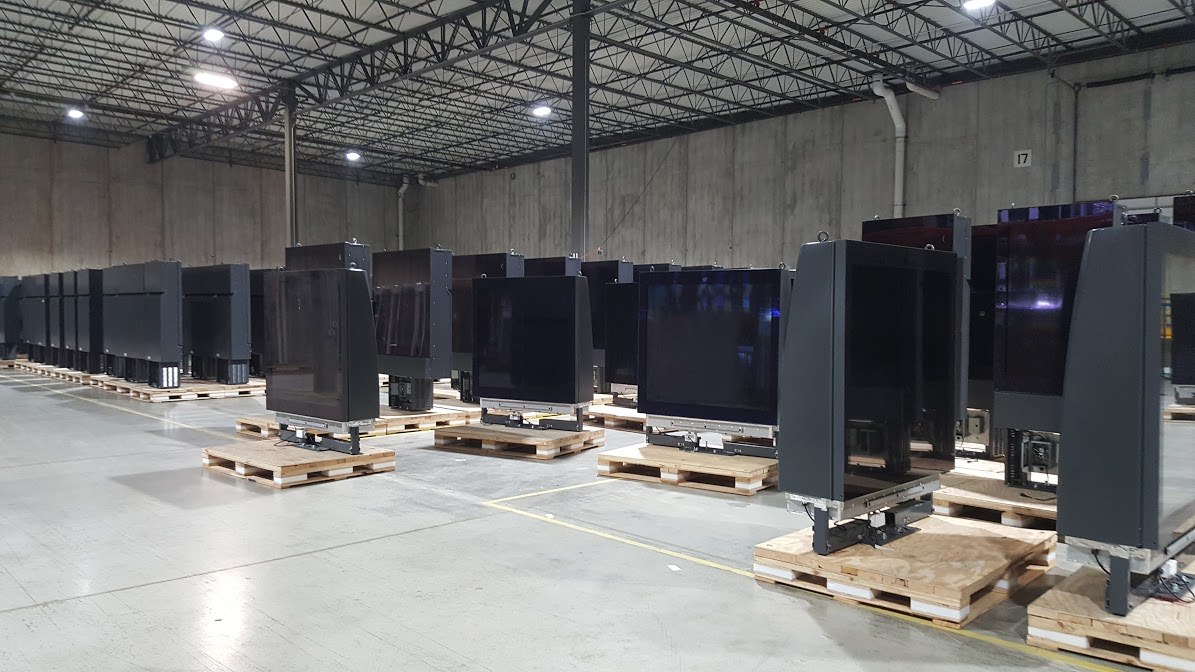
Rapid Build
The ramp-up has been rapid. The display business came out of the acquisition of the menu board side of Toronto’s Vertigo Displays, also in the summer of 2016. Vertigo had earlier been acquired by the Civiq smart cities people, but that company wanted the outdoor street furniture expertise and evidently had no real need for the outdoor drive-thru expertise Vertigo also possessed.
“Generally speaking I would say a software company has no business being in the manufacturing business, and I was 100% aligned with that,” says Riegel, saying the Vertigo deal got him IP, expertise and design chops.
“I bought this large facility and then we decided, ‘Hey, let’s become a manufacturer of this stuff.’ And, in doing so, it became super clear, super quickly, that the only way you were going to be successful doing that was to bring in manufacturing guys and bring in the process, bring in the discipline, bring in the expertise to do it.”
Outdoor displays used as street furniture and menu displays tend to be built by most vendors in relative small batches, and are almost hand-crafted. LG-MRI has a very large and impressive assembly plant in suburban Atlanta, but is not set up as an assembly line line, the way this is. At least it wasn’t when I saw it in 2016.
Riegel, STRATACACHE’s sole owner, has invested millions in the Dayton facility and fired up manufacturing that feels like what you see in an auto assembly plant. That makes sense, as Brown is one of several managers hired on who have direct backgrounds in auto manufacturing, including working in Japan in Toyota and Honda factories.
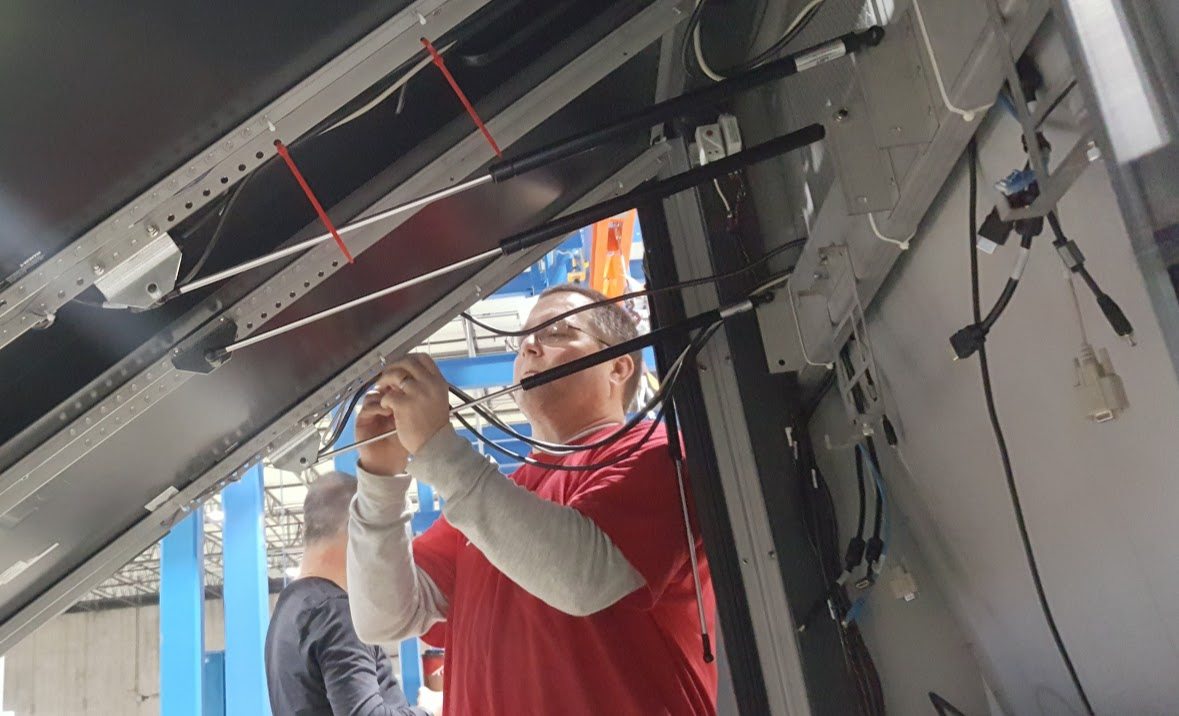
Big Blue Beast
There is a giant steel beam beast of a machine with tracks and wire rope cables and hooks and lifts. Work starts at one end with a powder-coated armature and frame and crews at stations and zones along the line progressively add wiring and sub-assembly components to the units, which suspended from the trestle, move progressively down the line. Major components like the LCD itself and the glass cover come in from the sides and get added on and attached.
At the far end, the finished product goes through a kind of super high pressure car wash that blasts water at 1,400 PSI at the display, to test that the unit is fully sealed from rain, snow and whatever else Mother Nature might throw at it. Once out of the wash, a quality assurance tech opens it up, looking for any moisture that might have seeped in if something was missed in the way gaskets and sealants were added along the way.
The whole thing is very impressive, not only in terms of the industrial look and scale, but the process that’s been built up and is now being continuously refined by Brown.
There are forklifts constantly tearing around the vast building, bringing in components and hauling off packaging. There are 1,000s of 55-inch LG commercial-grade high-bright LCDs stacked in inventory. Pupo says they order inventory 6,000 displays at a time, a phone call or email that like sets some LG key accounts sales person into happy dance mode. That would be serious commission.
STRATACACHE as a blended business, that rolls in two other CMS software companies with QSR clients, has a healthy chunk of the North American business. QSR drive-thru is a business that is all about pre-selling and promoting specials as motorists roll through the lane, and then presenting ordering options at a large single display, or a cluster of them.
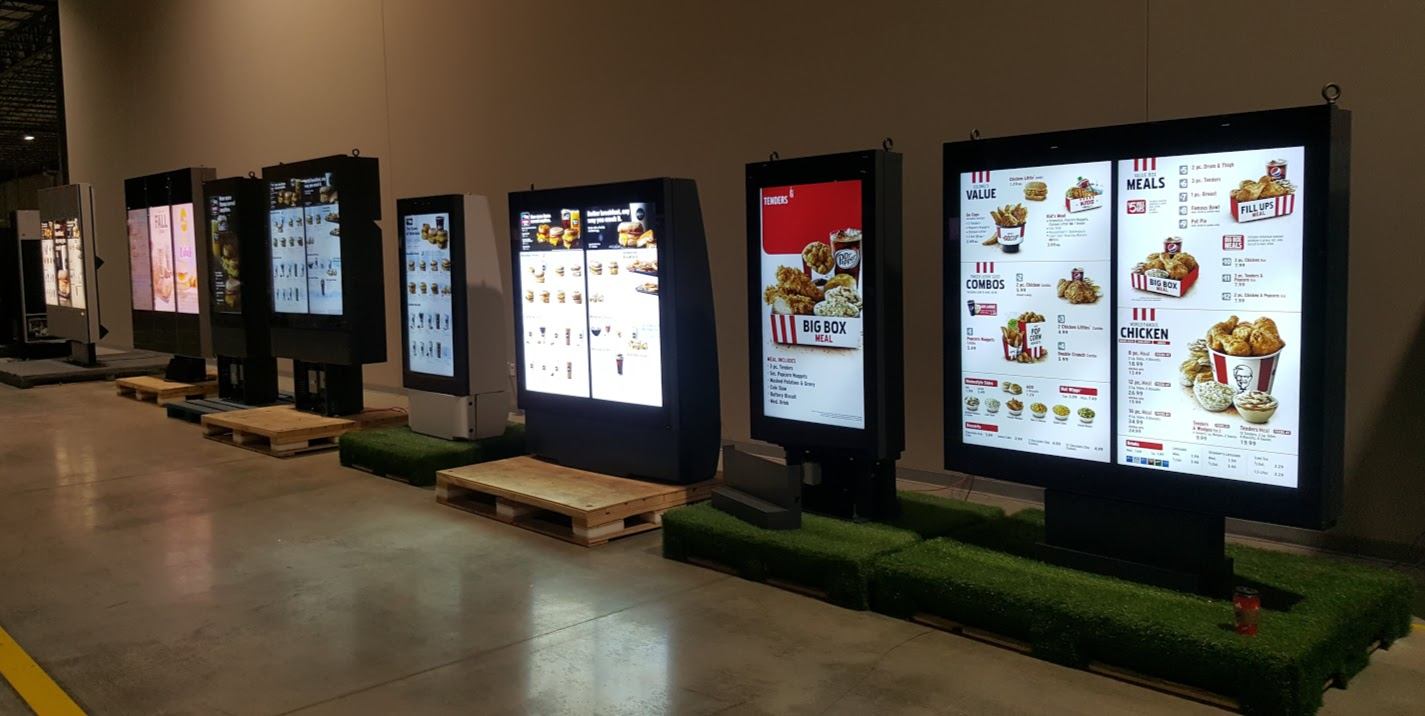
Building For Outdoor
The outdoor business is very different from indoor menu boards because the displays have to survive all the elements, keep operating under the full heat-load of mid-afternoon sun, and overpower direct sunlight’s glare. They also have to deal with insidious things like corrosive, airborne salt from road de-icing programs across much of North America.
Probably STRATACACHE’S biggest client is McDonald’s, though it has several other big, national banners. None of the big guys like vendors talking up their arrangements, but I could see numerous national fast food brands on test screens. A big gas/c-store chain was on a due diligence plant tour while I was there yesterday.
A lot of those operators are still running their drive-thrus using print signs in lightboxes, so the conversion potential is massive. Beyond the majors, there are more than 200,000 total QSRs in the US. Only a percentage have drive-thrus, which means many, many 1,000s of possible outdoor displays. Some of the rollouts underway involve a pre-sell screen and twin order display in each of two drive-thru lanes.
Riegel didn’t want to talk publicly about numbers, but expects sales will quadruple in 2018.
“Outdoor digital menu boards are at this same kind of intersection point that indoor was two years ago,” says Riegel, referencing the shift that happened inside stores, with digital menus transforming from nice-to-haves to standard elements of stores. “If you’re going to build a new store, you build it with an outdoor digital. If you are going to retrofit a store, the cost of digital is about a 20 to 22 percent premium over print. So you’re going to drop to $2 million on a new store, you are going to do digital. It is just a no brainer.”
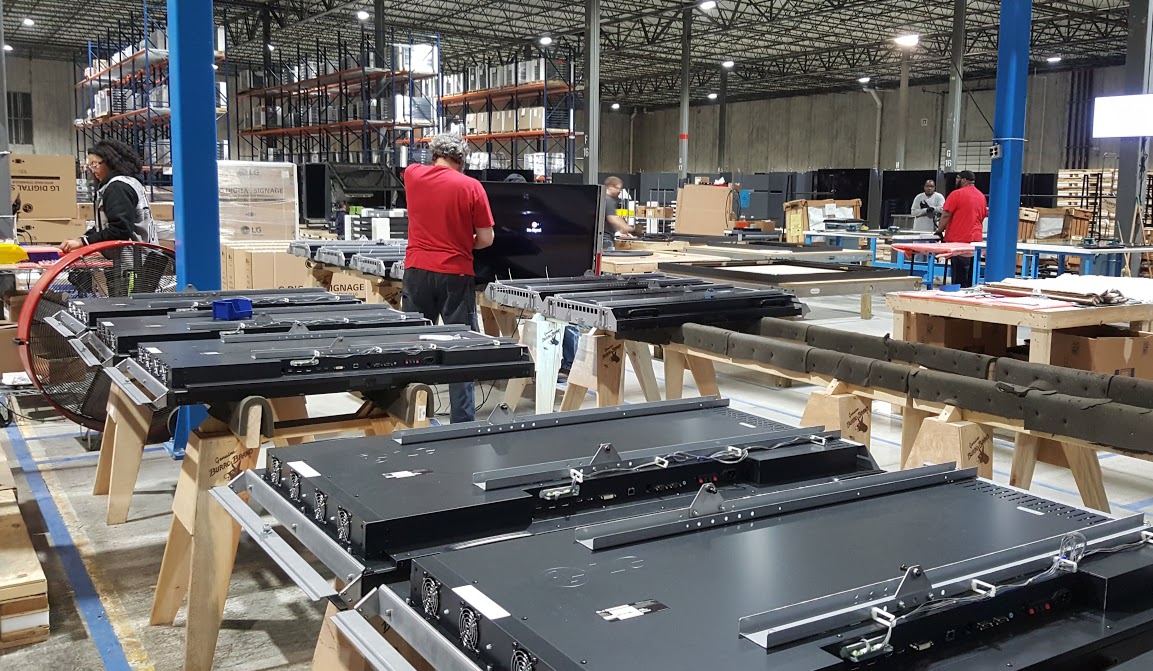
Labor costs remain much lower in China than the U.S., but that gap has closed. STRATACACHE gets sub-assembly components from China and Korea, but the displays are built in Dayton. That cuts out shipping costs and speeds up turnaround times. State-side manufacturing also allows the company to be much more agile, able to react quickly when customers change their minds about things like finishes.
The gold standard in outdoor display is almost universally thought to be Atlanta-based LG-MRI, which markets outdoor displays with 10-year warranties, while many competitors sell product expected to last three to five. Riegel says his product is warrantied for five years, and sees that as a pragmatic solution that allows him to market a high-quality product at a price not possible if he was selling 10-year rated equipment.
“That being said, I think LG MRI are probably overbuilding for the markets that we serve, because their good product comes at a Bentley kind of price. My goal in life here is to build a good Toyota or Chevrolet.“
LG-MRI’s main line of business is digital out of home, but the company is also making and marketing product for drive-thru. The company is unabashed about its product costing more, but argues the long-term TCO works out because of longevity and reliability.
Why Now
There are a few reasons why Riegel has ramped up production now, and why he expects the investment will pay off. Putting manufacturing processes, disciplines and supply chains in place can shave about 40% of the bill of materials costs. Focusing the actual assembly work and eliminating a lot of wasted movement has meant the same size of team can produce a lot more units in one shift. Right now, they are doing an average of 34 displays in a shift, but have done as many as 56.
The factory has about 90 workers, the majority working out on the floor and in and around the assembly line. The plant also supports the company’s Optika specialty interactive displays, and Primasee, the transparent LCD product married with grocery chiller and freezer doors. That latter product, around for a few years, seems to finally be getting some traction from brands, the company says.
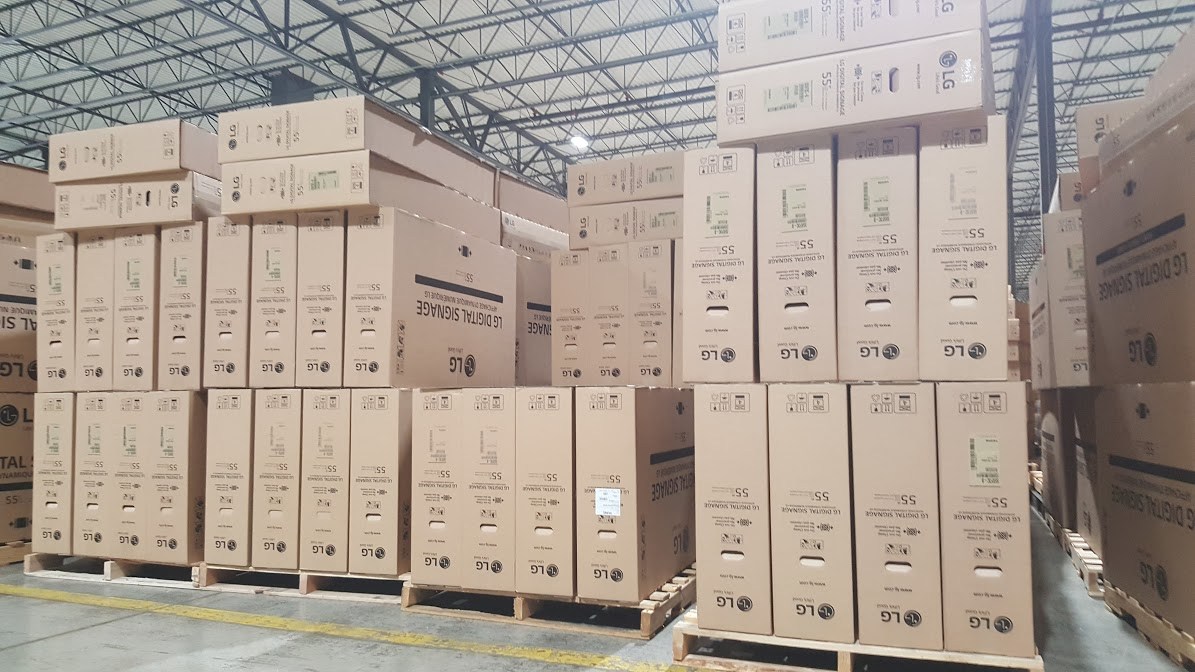
Getting into mass production is also possible because display costs have come down and STRATACACHE is buying in big volume from LG. I was a bit surprised to see Riegel all-in with LG, as he’s not always had the sunniest of relationships with the big Korean displaycos. But he says LG quite simply has the best high-brightness product for the task.
I wasn’t entirely sure what I might see in coming down to Dayton. Digital signage is a still a pretty small industry, and with the exception of the major display companies, I rarely get a sense of real, industrial-style scale to what companies are doing. This place was very different. Riegel has always positioned his business to go after “whale” accounts like the biggest mass market retailers and food service operators, and the plant on the renamed Stratacache Way is an effort to serve that size of client.
There are a lot of great vendors in this industry who produce quality hardware, but I’ve not seen many facilities even approaching this kind of investment and ambition.
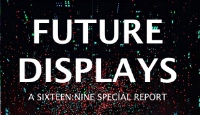


Leave a comment